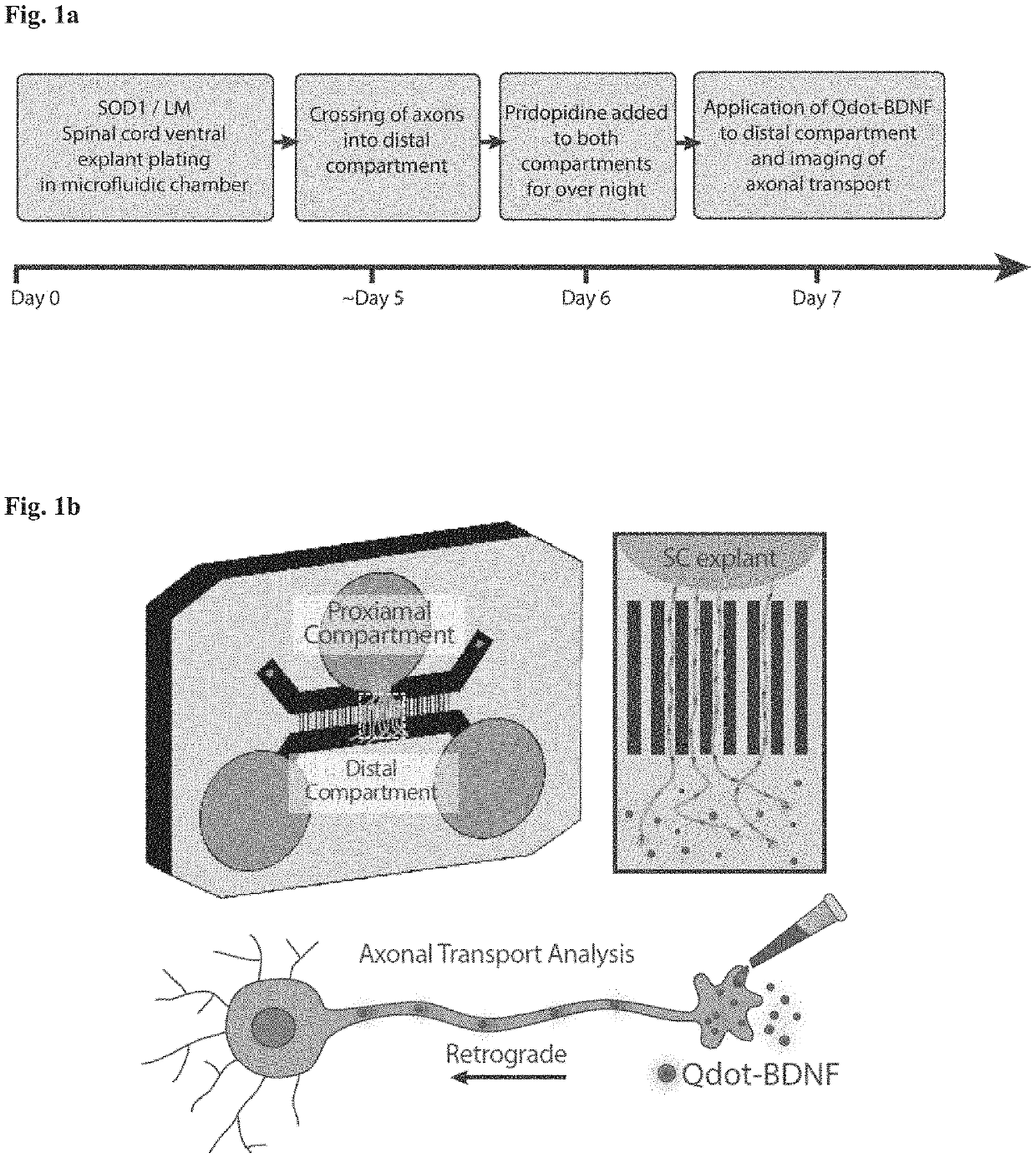Method of treating amyotrophic lateral sclerosis with pridopidine
a technology of amyotrophic lateral sclerosis and pridopidine, which is applied in the direction of heterocyclic compound active ingredients, drug compositions, anhydride/acid/halide active ingredients, etc., can solve the problems speak and eventually breathe, and the loss of limb function and the ability to chew, swallow, and eventually swallow
- Summary
- Abstract
- Description
- Claims
- Application Information
AI Technical Summary
Benefits of technology
Problems solved by technology
Method used
Image
Examples
experiment 1
port Assays
[0221]Healthy motor neurons (MN) extend axons over long distances and through varying extracellular microenvironments to form synapses with muscles. The ability of the neuron to maintain this specialized morphology depends on cytoskeletal elements and continuous transport of proteins and organelles to and from the cell body. Cytoskeletal alterations are a major pathway implicated in the pathogenesis of ALS affecting axonal transport, growth and neuromuscular junction (NMJ) function (Eykens and Robberecht, 2015). Alterations in axonal transport are one of the first cellular processes that occur in neurodegenerative disease, including ALS. Axonal transport was evaluated using an in vitro compartmentalized system of microfluidic chambers (MFC) that separates neuronal cell bodies from their axons and synapses, enabling the study of retrograde / anterograde transport by specific monitoring and manipulation of cellular microenvironments (FIG. 1b: Zahavi 2015; Ionescu 2016).
[0222]...
experiment 2
Growth / Degeneration Assays
[0231]An early event in the pathogenesis of ALS is axonal degeneration. The compartmental co-culture microfluidic chamber system was used to determine whether pridopidine alters axonal degeneration (FIG. 3). Primary muscle cells from presymptomatic (P60) WT or SOD1G93A mice were cultured. On day 6 primary skeletal myoblasts were cultured in the distal compartment of a MFC. About six days later (day 12), ventral spinal cord explants from WT or SOD1G93A E12.5 mouse embryos that express HB9-GFP (a specific motor neuron marker) were plated in the proximal compartment, followed by application of pridopidine or vehicle to both compartments. Pridopidine was refreshed every other day. Two days post explant plating (day 14), motor axon growth and degeneration were evaluated using live imaging on a spinning disc confocal system. Axonal growth was tracked by imaging every 10 min for 8 hrs. Experiments were repeated three times.
[0232]Results:
[0233]The data demonstrate ...
experiment 3
of Neuromuscular Junction (NMJ) Formation and Function
[0235]Synapse disruption is the earliest cellular compartment disrupted in ALS. To test the ability of pridopidine to affect synapse function in an ALS model, cultures from Experiment 2 were grown for approximately four additional days (day 18), when axons extend into the distal compartment and generate NMJs. In this co-culture, MN axons formed NMJs on fully differentiated primary myocytes.
[0236]These can be observed by the co-localization of the post-synaptic marker (AchR, ecetyl choline receptor) with the Hb9:GFP neuronal marker. FIG. 5a: Upper panel: Phase-contrast microscope image of a myocyte in the distal compartment connected by axons (arrowheads). Scale bar: 201 μm. Lower panel: High magnification images of myocyte:MN contact points reveal the formation of NMJs as seen by co-localization of post synaptic AChR with HB9::GFP axons and 3-dimensional co-localization of pre and post-synaptic markers (coloc). To evaluate NMJ fu...
PUM
| Property | Measurement | Unit |
|---|---|---|
| mass | aaaaa | aaaaa |
| diameter | aaaaa | aaaaa |
| diameter | aaaaa | aaaaa |
Abstract
Description
Claims
Application Information
 Login to View More
Login to View More - R&D
- Intellectual Property
- Life Sciences
- Materials
- Tech Scout
- Unparalleled Data Quality
- Higher Quality Content
- 60% Fewer Hallucinations
Browse by: Latest US Patents, China's latest patents, Technical Efficacy Thesaurus, Application Domain, Technology Topic, Popular Technical Reports.
© 2025 PatSnap. All rights reserved.Legal|Privacy policy|Modern Slavery Act Transparency Statement|Sitemap|About US| Contact US: help@patsnap.com



